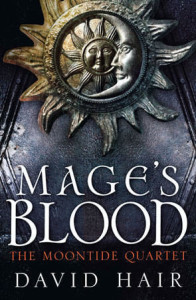 The folks at Jo Fletcher don’t seem to be capable of disappointing. I’ve yet to read a book I wasn’t pleased with from them.
The folks at Jo Fletcher don’t seem to be capable of disappointing. I’ve yet to read a book I wasn’t pleased with from them.
What first drew me to Mage’s Blood was the clash of civilizations. East versus West. Religion versus religion. Crusades. These are all fairly standard ideas/tropes in fantasy. They’re done often. No matter how often I read about them, I still find the aspect of different peoples clashing, especially different religions, incredibly compelling – exploring why they’re fighting and so on. For more on religion in fantasy, check out Teresa Frohock’s post from not too long ago. Opinions vary, some love it and some don’t – it depends on how well the author portrays the various religions. David Hair does very well.
The beginning to Mage’s Blood has been described as slow by several people. I love some good action, and in fact I probably prefer books with action in them. Hair starts us off with vivid detail in every sense of the word – very little action occurs. The people, cultures, and landscape, and world are the focal points of the first hundred or so pages. What I’m also a big fan of is detail when it comes to the world. The map printed on the inside cover was a fantastic tool to have throughout the story. At the beginning of every chapter is a short paragraph on some part of the history of the world – what happened at this place, how this form of magic works, and so on – add this to the strongly balanced worldbuilding that expands as the story unfolds and you have the means to an excellent work of literature. The novel really hits its stride, though, at around the 200 page mark (it’s not a struggle to read the first 200 though).
Every dozen years, the Leviathan Bridge rises above sea level and becomes traversable – known as the Moontide. For the past two Moontides, the people on both sides of the Bridge have clashed in crusades and shihads – holy wars. The people of the Rondian Empire to the west, on the continent of Yuros, are given magic – gnosis – in their theology, and Hair describes it in detail throughout the story and their religion strongly resembles European Christianity. The people of the eastern continent, Antiopia, are comprised of followers of Ahm, similar to Arabic culture and Islam, and people of Lakh, seen as Indian in culture and theology. The holy city where all the religious strife is centered is even named Hebusalim – sound familiar? So while the cultures and places themselves are not completely unique and original, they are presented in a very engaging way, making this 700 page epic breeze right along.
Mage’s Blood is told from the perspective of three primary characters as well as many other minor characters. I was genuinely surprised that Hair was able to juggle so many characters with a deft hand. Alaran Mercer is a quarter-blood mage, meaning that he can wield the magic, the gnosis, but is not all-powerful like a pureblood or Ascendant might be. Alaron’s initial arc is fairly standard and tropey – a young man going to a school to learn magic – but it turns into a much more compelling story and his is probably the one I am most looking forward to in the sequel. Elena Anborn, Alaron’s aunt, is a half-blood warrior-mage in service of Gurvon Gyle, a sort of spymaster for the Rondian throne. She is tasked to guard the Nesti royal family, who rule Javon, a region in northern Antiopia. She grows fond of the family she is tasked to protect and when her orders come, she has a difficult decision to make. Elena is a great character who has had so much happen to her, and the story as we know it is just beginning – she becomes very easy to empathize with. Ramita Ankesharan is the final ‘main’ character. She’s a young Lakh girl who gets thrown into a world that’s way over her head due to her father’s greed. Alongside these three there are several others, including Gyle himself, a princess, a particularly foul-mouthed saint, and more. Sometimes you’ll have a story from one character that ends up connecting with the past of another, and that is pretty awesome.
Possibly the strongest aspect of Mage’s Blood is its cultural diversity. While the continent of Yuros is fairly standard and European, Antiopia is brimming with diversity. Throughout the story the people of Yuros and Antopia are seen wearing cultural garb, be they turbans, burkas, or many other forms of clothing and jewelry. Not only is the clothing diverse, there are terms and phrases of various origins, Italian, Spanish, Indian, Arabic and more – most of which I had to look up. This isn’t a bad thing – I like to learn while I read. It seemed to me upon reading the definitions that they were used correctly, but then again I’m no expert in any of said cultures. From the cities to the people inhabiting them, the world of Urte felt very real.
Magic. With a title like Mage’s Blood, you know there will be magic of some sort – but how in-dept will it be? Will it be a simple fireball-style system that can be cast at will or will it be a detailed Sanderson-esque system where everything comes at a cost? Hair gives us the latter. There are different schools of the gnosis that is explained very well in both the story and the chapter headers. The best part? Hair writes magic duels to rival Sanderson. Mages can do more or less anything – shapeshift, create magical shields that redirect or block magic, bring the dead back to life, heal, and more. The system is well thought out and detailed – you’ll feel the fire scorch the earth around you.
Mage’s Blood is true epic fantasy. It has everything a fan could want – detailed magic, good characters and evil characters (of both genders) and some in between, a compelling plot, and twists aplenty. At first glance, it seems like, at nearly 700 pages, that some things could be cut out to trim it to a more feasible size. I don’t think that’s the case for Mage’s Blood. It felt like every word was more or less in its place and necessary, and the plot moved quickly to boot. I cannot wait to read the sequel, The Scarlet Tides, and will likely read it as soon as it arrives. It’s nice to see newer fantasy stories set in places that aren’t strictly medieval Europe. With Elizabeth Bear’s Eternal Sky set in the steppes of Mongolia, The Chronicles of Sword and Sand from Howard Andrew Jones set in Baghdad, and several others, this is a trend I would gladly see continue in the future.
end-note: In their reviews, Justin Landon and Fantasy Book Critic both wrote about the problem of the people being so similar even though the two continents have been separate for centuries – a form of cognitive dissonance. This thought never occurred to me as I was reading perhaps because I’m not nearly as jaded, so I suppose it really depends what you’re hunting for.
Find Mage’s Blood at:
Amazon (US)
and find David on his website.

Hi Pat,
Thanks for the great review & remember I told you so 😉
Btw the point that you brought has been answered by the author in our Interview with him. Pretty nifty world he’s got here.
Must have missed the interview, thanks for the link!